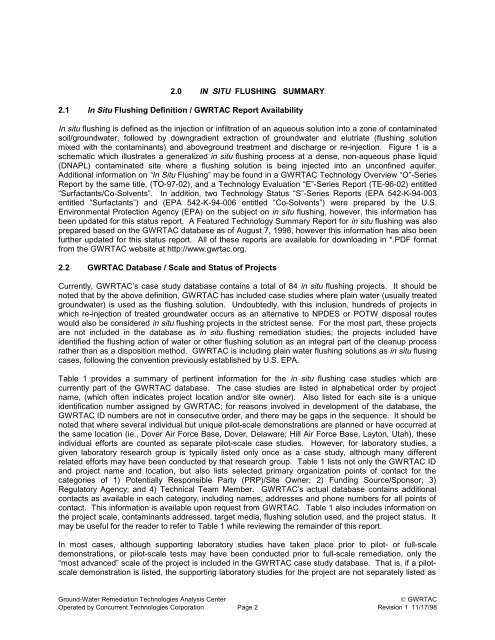Technology Status Report: In Situ Flushing - CLU-IN
Technology Status Report: In Situ Flushing - CLU-IN
Technology Status Report: In Situ Flushing - CLU-IN
Create successful ePaper yourself
Turn your PDF publications into a flip-book with our unique Google optimized e-Paper software.
2.0 <strong>IN</strong> SITU FLUSH<strong>IN</strong>G SUMMARY<br />
2.1 <strong>In</strong> <strong>Situ</strong> <strong>Flushing</strong> Definition / GWRTAC <strong>Report</strong> Availability<br />
<strong>In</strong> situ flushing is defined as the injection or infiltration of an aqueous solution into a zone of contaminated<br />
soil/groundwater, followed by downgradient extraction of groundwater and elutriate (flushing solution<br />
mixed with the contaminants) and aboveground treatment and discharge or re-injection. Figure 1 is a<br />
schematic which illustrates a generalized in situ flushing process at a dense, non-aqueous phase liquid<br />
(DNAPL) contaminated site where a flushing solution is being injected into an unconfined aquifer.<br />
Additional information on “<strong>In</strong> <strong>Situ</strong> <strong>Flushing</strong>” may be found in a GWRTAC <strong>Technology</strong> Overview “O”-Series<br />
<strong>Report</strong> by the same title, (TO-97-02), and a <strong>Technology</strong> Evaluation “E”-Series <strong>Report</strong> (TE-96-02) entitled<br />
“Surfactants/Co-Solvents”. <strong>In</strong> addition, two <strong>Technology</strong> <strong>Status</strong> “S”-Series <strong>Report</strong>s (EPA 542-K-94-003<br />
entitled “Surfactants”) and (EPA 542-K-94-006 entitled “Co-Solvents”) were prepared by the U.S.<br />
Environmental Protection Agency (EPA) on the subject on in situ flushing, however, this information has<br />
been updated for this status report. A Featured <strong>Technology</strong> Summary <strong>Report</strong> for in situ flushing was also<br />
prepared based on the GWRTAC database as of August 7, 1998, however this information has also been<br />
further updated for this status report. All of these reports are available for downloading in *.PDF format<br />
from the GWRTAC website at http://www.gwrtac.org.<br />
2.2 GWRTAC Database / Scale and <strong>Status</strong> of Projects<br />
Currently, GWRTAC’s case study database contains a total of 84 in situ flushing projects. It should be<br />
noted that by the above definition, GWRTAC has included case studies where plain water (usually treated<br />
groundwater) is used as the flushing solution. Undoubtedly, with this inclusion, hundreds of projects in<br />
which re-injection of treated groundwater occurs as an alternative to NPDES or POTW disposal routes<br />
would also be considered in situ flushing projects in the strictest sense. For the most part, these projects<br />
are not included in the database as in situ flushing remediation studies; the projects included have<br />
identified the flushing action of water or other flushing solution as an integral part of the cleanup process<br />
rather than as a disposition method. GWRTAC is including plain water flushing solutions as in situ flusing<br />
cases, following the convention previously established by U.S. EPA.<br />
Table 1 provides a summary of pertinent information for the in situ flushing case studies which are<br />
currently part of the GWRTAC database. The case studies are listed in alphabetical order by project<br />
name, (which often indicates project location and/or site owner). Also listed for each site is a unique<br />
identification number assigned by GWRTAC; for reasons involved in development of the database, the<br />
GWRTAC ID numbers are not in consecutive order, and there may be gaps in the sequence. It should be<br />
noted that where several individual but unique pilot-scale demonstrations are planned or have occurred at<br />
the same location (ie., Dover Air Force Base, Dover, Delaware; Hill Air Force Base, Layton, Utah), these<br />
individual efforts are counted as separate pilot-scale case studies. However, for laboratory studies, a<br />
given laboratory research group is typically listed only once as a case study, although many different<br />
related efforts may have been conducted by that research group. Table 1 lists not only the GWRTAC ID<br />
and project name and location, but also lists selected primary organization points of contact for the<br />
categories of 1) Potentially Responsible Party (PRP)/Site Owner; 2) Funding Source/Sponsor; 3)<br />
Regulatory Agency; and 4) Technical Team Member. GWRTAC’s actual database contains additional<br />
contacts as available in each category, including names, addresses and phone numbers for all points of<br />
contact. This information is available upon request from GWRTAC. Table 1 also includes information on<br />
the project scale, contaminants addressed, target media, flushing solution used, and the project status. It<br />
may be useful for the reader to refer to Table 1 while reviewing the remainder of this report.<br />
<strong>In</strong> most cases, although supporting laboratory studies have taken place prior to pilot- or full-scale<br />
demonstrations, or pilot-scale tests may have been conducted prior to full-scale remediation, only the<br />
“most advanced” scale of the project is included in the GWRTAC case study database. That is, if a pilotscale<br />
demonstration is listed, the supporting laboratory studies for the project are not separately listed as<br />
Ground-Water Remediation Technologies Analysis Center © GWRTAC<br />
Operated by Concurrent Technologies Corporation Page 2 Revision 1 11/17/98
















